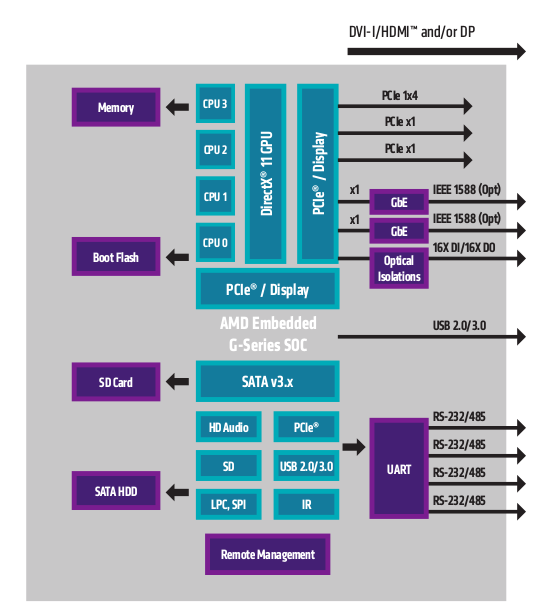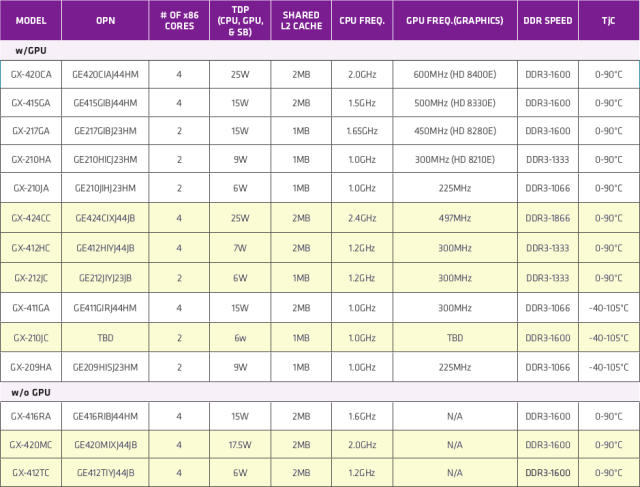AMD has added six new members to is Embedded G-Series family with “Steppe Eagle” SoCs comprising a CPU, GPU and I/O in a single chip, and “Crowned Eagle” CPUs that are not actually CPUs in the old sense, but SoCs comprised of a CPU and I/O chipset, and all of them also include AMD’s ARM based PSP (Platform Security Processor) built upon ARM TrustZone architecture. You may also remember AMD G-Series APUs which are comprised of a CPU and GPU, and connected to an external I/O chipset, but none of these were announced today.

The six new AMD G-Series processors are as follows:
- “Steppe Eagle” SoCs:
- GX-424CC – Quad core @ 2.4 GHz with 2MB L2 cache, and a GPU @ 497MHz. DDR3-1866 support. TDP: 25W
- GX-412HC – Quad core @ 1.2 GHz with 2MB L2 cache, ad a GPU @ 300MHz. DDR3-1333 support. TDP: 7W
- GX-212JC – Dual core @ 1.2 GHz with 1MB cache, and a GPU @ 300 MHz. DDR3-1333 support. TDP: 2 6W
- GX-210JC – Dual core @ 1.0 GHz with 1MB and a GPU (freq TDB). DDR3-1600 support. TDP: 6W
- “Crowned Eagle” CPUs:
- GX-420MC – Quad core @ 2.0GHz with 2MB L2 cache. DDR3-1600 support. TDP: 17.5W
- GX-412TC – Quad core @ 1.2GHz with 2MB L2 cache. DDR3-1600 support. TDP: 6W
All model have a junction temperature range (TjC) between 0 and 90°C, except GX-210JC with an extended temperature range between -40 to 105°C. I’ve highlighted the six new models in the tablet below will all Embedded G-Series SoC from the company’s product brief.

AMD claims up to 53 percent more overall performance compared to previous G-Series SoC solutions, as well as pin-to-pin compatibility for Steppe Eagle SoCs. One of the first design will be Advantech AIMB-225, and industrial grade mini-ITX motherboard features both dual- and quad-core solutions, and targeting applications such as ATMs, kiosks, automation, gaming machines and medical equipment. Steppe Eagle SoCs will also be used in some of Hewlett Packard (HP) thin clients for healthcare, finance, education and retail markets.
GPU-less “Crowned Eagle” SoCs are destined to be used in datacenters for networking and communication infrastructure applications. These 64-bit CPUs are said to feature integrated PCI-E Gen 2.0, USB3.0, SATA ports, and single-channel DDR3-1600 memory with ECC support. AMD claims 34 percent more CPU-centric performance-per-dollar than competing Intel solutions, but they haven’t disclosed which ones…
The performance-per-watt of the new platforms is said to be nearly double compared to previous G-Series SoCs, which has been achieved thanks to improvement such as configurable TDP (cTDP). Embedded Linux development and commercial support for the AMD G-Series family will be provided though Mentor Embedded Linux and Sourcery CodeBench. A no-cost Mentor Embedded Linux Lite is also available, which is based on the Yocto Project.
You can find more details via AMD press release, blog post, and AMD Embedded G-Series product page.

Jean-Luc started CNX Software in 2010 as a part-time endeavor, before quitting his job as a software engineering manager, and starting to write daily news, and reviews full time later in 2011.
Support CNX Software! Donate via cryptocurrencies, become a Patron on Patreon, or purchase goods on Amazon or Aliexpress




